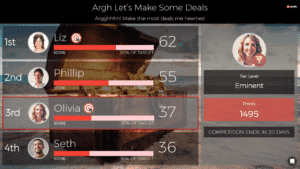What do we want?
Leaderboards? No, knowledge. That’s what we want, meaningful, analytical, actionable information that prompts the receivers of said information to do new or existing activities.
In an age of big data, one of the disappointments for companies is that they are not truly data-driven. Executives have regularly tried to reduce the ocean of data available into one page of key metrics, dashboard or balanced scorecard which provide a status position at a point in time. These are basically reports and lack a call to action. It is easier to manage people to do more business activities when the information provided, clearly shows what has been achieved and what still needs to be done as an individual and as part of a team.
Dashboard data also focuses on the executive, when those who can move the needle on company performance are the workers. They thirst for meaningful information about their performance and what they need to do to improve.
When do we want It?
Now. The answer is always now. And more than being about Now it’s also about real-time updates. Relevancy and currency are important components of actionable information. In order to know if their day to day work has an impact on the business outcomes so they can feel good about this contribution, individual team members need constant updates about their performance and how they compare to their colleagues.
What’s the Answer?
In one word – Leaderboards. Leaderboards provide real time updated feedback on staff performance and highlights the gaps in performance between them and their colleagues. Unlike dashboards that focus on reporting on the ‘top’ performers, missing the long tail insights, leaderboards focus on all team members and show the opportunities to move the middle and have an even bigger impact on business results.
Context is everything and leaderboards allow you to filter business objectives so that staff focus on the metrics which really matter. This can mean drilling down from the outcomes (such as deals won) to the lead indicators such as how many calls a sales rep made today, how many quotes did they send out, how many prospects did they convert to customers. When this micro information is available in a colorful and easily read visualisation the drive for uplift is even more effective.
Leaderboards do not leave data or performance interpretation to management. They take away the long established practice of executives providing their opinion on recommendations for actions with benefit of their wisdom and awareness of business strategy. We do need managers to recognize opportunities to train, coach or mentor their staff and again leaderboards highlight these opportunities with real time up to the minute performance information. New challenges demand new actions not a reliance on the way it used to be done. Leaderboards are objective representations of data and remove any subjectivity about performance from discussions between managers and their team members.
A picture tells a thousand words and clever leaderboards that show information about an individual and their colleagues that is easy to see and understand will drive better uplift in performance.

Conclusion
There are many reasons why your dashboards may suck. Luckily it is easy to remedy for your organization. Leaderboards that remove complexity from big data, and visualize it in an engaging format will maintain staff motivation and encourage an uplift in productivity. Leaderboards are not reports. They include insights such as the progress of staff against their targets or a predictor of whether or not they can achieve target based on current performance levels in the time still remaining.
This may be controversial but let me say it anyway. The primary purpose of business information is not to inform, and it is not to educate. The primary purpose is to drive action! And the best way to do this is with leaderboards.
For more news and updates, follow us on our social media profiles: LinkedIn and Twitter



